[ ]:  | Symbol | Order |
|---|
| [1]+ | 1.1 | | [1] = [ ] | 2.1 | [2]:    | Symbol | Order |
|---|
| [1+,2]+ | 1.1 | | [2]+ | 2.1 | | [2] | 4.1 | [2,2]:      | Symbol | Order |
|---|
[2+,2+]+
= [(2+,2+,2+)] | 1.1 | | [2+,2+] | 2.1 | | [2,2]+ | 4.1 | | [2+,2] | 4.1 | | [2,2] | 8.1 | [2,2,2]:        | Symbol | Order |
|---|
[(2+,2+,2+,2+)]
= [2+,2+,2+]+ | 1.1 | | [2+,2+,2+] | 2.1 | | [2+,2,2+] | 4.1 | | [(2,2)+,2+] | 4 | | [[2+,2+,2+]] | 4 | | [2,2,2]+ | 8 | | [2+,2,2] | 8.1 | | [(2,2)+,2] | 8 | | [[2+,2,2+]] | 8.1 | | [2,2,2] | 16.1 | | [[2,2,2]]+ | 16 | | [[2,2+,2]] | 16 | | [[2,2,2]] | 32 | | [p]:    | Symbol | Order |
|---|
| [p]+ | p | | [p] | 2p | [p,2]:      | Symbol | Order |
|---|
| [p,2]+ | 2p | | [p,2] | 4p | [2p,2+]:       | Symbol | Order |
|---|
| [2p,2+] | 4p | | [2p+,2+] | 2p | [p,2,2]:        | Symbol | Order |
|---|
| [p+,2,2+] | 2p | | [(p,2)+,2+] | 2p | | [p,2,2]+ | 4p | | [p,2,2+] | 4p | | [p+,2,2] | 4p | | [(p,2)+,2] | 4p | | [p,2,2] | 8p | [2p,2+,2]:         | Symbol | Order |
|---|
| [2p+,2+,2+]+ | p | | [2p+,2+,2+] | 2p | | [2p+,2+,2] | 4p | | [2p+,(2,2)+] | 4p | | [2p,(2,2)+] | 8p | | [2p,2+,2] | 8p | | [p,2,q]:        | Symbol | Order |
|---|
| [p+,2,q+] | pq | | [p,2,q]+ | 2pq | | [p+,2,q] | 2pq | | [p,2,q] | 4pq | [(p,2)+,2q]:         | Symbol | Order |
|---|
| [(p,2)+,2q+] | 2pq | | [(p,2)+,2q] | 4pq | [2p,2,2q]:          | Symbol | Order |
|---|
[2p+,2+,2q+]+=
[(2p+,2+,2q+,2+)] | pq | | [2p+,2+,2q+] | 2pq | | [2p,2+,2q+] | 4pq | | [((2p,2)+,(2q,2)+)] | 4pq | | [2p,2+,2q] | 8pq | [[p,2,p]]:        | Symbol | Order |
|---|
| [[p+,2,p+]] | 2p2 | | [[p,2,p]]+ | 4p2 | | [[p,2,p]+] | 4p2 | | [[p,2,p]] | 8p2 | [[2p,2,2p]]:          | Symbol | Order |
|---|
| [[(2p+,2+,2p+,2+)]] | 2p2 | | [[2p+,2+,2p+]] | 4p2 | | [[((2p,2)+,(2p,2)+)]] | 8p2 | | [[2p,2+,2p]] | 16p2 | | [3,3,2]:        | Symbol | Order |
|---|
[(3,3)Δ,2,1+]
≅ [2,2]+ | 4 | [(3,3)Δ,2]
≅ [2,(2,2)+] | 8 | [(3,3)⅄,2,1+]
≅ [4,2+] | 8 | [(3,3)+,2,1+]
= [3,3]+ | 12.5 | [(3,3)⅄,2]
≅ [2,4,2+] | 16 | [3,3,2,1+]
= [3,3] | 24 | | [(3,3)+,2] | 24.10 | | [3,3,2]+ | 24.10 | | [3,3,2] | 48.36 | [4,3,2]:        | Symbol | Order |
|---|
[1+,4,3+,2,1+]
= [3,3]+ | 12 | | [3+,4,2+] | 24 | | [(3,4)+,2+] | 24 | [1+,4,3+,2]
= [(3,3)+,2] | 24.10 | [3+,4,2,1+]
= [3+,4] | 24.10 | [(4,3)+,2,1+]
= [4,3]+ | 24.15 | [1+,4,3,2,1+]
= [3,3] | 24 | [1+,4,(3,2)+]
= [3,3,2]+ | 24 | | [3,4,2+] | 48 | | [4,3+,2] | 48.22 | | [4,(3,2)+] | 48 | | [(4,3)+,2] | 48.36 | [1+,4,3,2]
= [3,3,2] | 48.36 | [4,3,2,1+]
= [4,3] | 48.36 | | [4,3,2]+ | 48.36 | | [4,3,2] | 96.5 | [5,3,2]:        | Symbol | Order |
|---|
[(5,3)+,2,1+]
= [5,3]+ | 60.13 | [5,3,2,1+]
= [5,3] | 120.2 | | [(5,3)+,2] | 120.2 | | [5,3,2]+ | 120.2 | | [5,3,2] | 240 (nc) | | [31,1,1]:      | Symbol | Order |
|---|
[31,1,1]Δ
≅[[4,2+,4]]+ | 32 | | [31,1,1]⅄ | 64 | | [31,1,1]+ | 96.1 | | [31,1,1] | 192.2 | <[3,31,1]>
= [4,3,3] | 384.1 | [3[31,1,1]]
= [3,4,3] | 1152.1 | [3,3,3]:        | Symbol | Order |
|---|
| [3,3,3]+ | 60.13 | | [3,3,3] | 120.1 | | [[3,3,3]]+ | 120.2 | | [[3,3,3]+] | 120.1 | | [[3,3,3]] | 240.1 | [4,3,3]:        | Symbol | Order |
|---|
[1+,4,(3,3)Δ]
= [31,1,1]Δ
≅[[4,2+,4]]+ | 32 | [4,(3,3)Δ]
= [2+,4[2,2,2]+]
≅[[4,2+,4]] | 64 | [1+,4,(3,3)⅄]
= [31,1,1]⅄ | 64 | [1+,4,(3,3)+]
= [31,1,1]+ | 96.1 | [4,(3,3)⅄]
≅ [[4,2,4]] | 128 | [1+,4,3,3]
= [31,1,1] | 192.2 | | [4,(3,3)+] | 192.1 | | [4,3,3]+ | 192.3 | | [4,3,3] | 384.1 | [3,4,3]:        | Symbol | Order |
|---|
| [3+,4,3+] | 288.1 | [3,4,3⅄]
= [4,3,3] | 384.1 | | [3,4,3]+ | 576.2 | | [3+,4,3] | 576.1 | | [[3+,4,3+]] | 576 (nc) | | [3,4,3] | 1152.1 | | [[3,4,3]]+ | 1152 (nc) | | [[3,4,3]+] | 1152 (nc) | | [[3,4,3]] | 2304 (nc) | [5,3,3]:        | Symbol | Order |
|---|
| [5,3,3]+ | 7200 (nc) | | [5,3,3] | 14400 (nc) | |


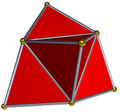
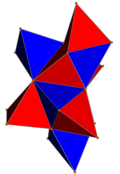
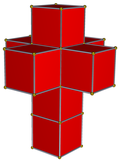
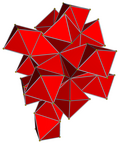
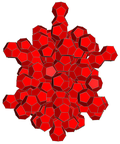
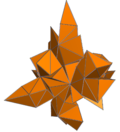
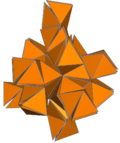
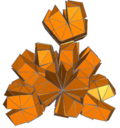
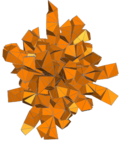




![[4,3], , octahedral pyramidal group is isomorphic to 3d octahedral symmetry Sphere symmetry group oh.svg](http://upload.wikimedia.org/wikipedia/commons/thumb/2/29/Sphere_symmetry_group_oh.svg/250px-Sphere_symmetry_group_oh.svg.png)




![[3,3], , tetrahedral pyramidal group is isomorphic to 3d tetrahedral symmetry Sphere symmetry group td.svg](http://upload.wikimedia.org/wikipedia/commons/thumb/b/bd/Sphere_symmetry_group_td.svg/250px-Sphere_symmetry_group_td.svg.png)




